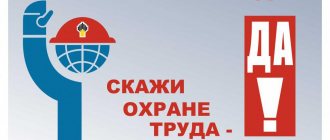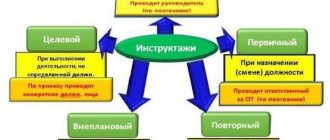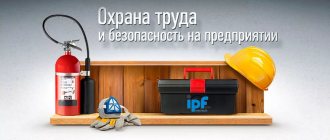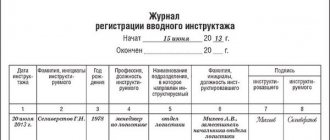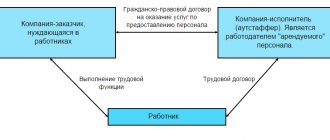What is needed at the enterprise
The employer must have instructions:
- About first aid.
- On fire safety.
- For each position.
- In the most traumatic areas of activity (when working with electricity, at heights, on vehicles, etc.).
The obligation to develop this document is enshrined in Article 212 of the Labor Code of the Russian Federation. Neglect on the part of the employer is punishable by a fine of up to 200,000 rubles or imprisonment for up to 5 years. Ignoring safety requirements by workers leads to injuries.
Universal safety requirements in emergency situations
Despite the fact that accidents are also different, there are a couple of common requirements. For example, providing first aid (for example, cardiopulmonary resuscitation or desmurgy), alerting rescue services and the immediate supervisor.
This also includes the rule not to touch anything at the scene of an incident (unless it threatens the health of the employee and his environment). And, perhaps, the most important thing in any workplace safety instructions: the priority of human life over material values.
Development
The development of regulatory documentation on occupational safety is carried out on the basis of intersectoral or industry standard instructions, regulatory documents of relevant departments, for example, Order of the Ministry of Labor No. 782n dated November 16, 2020 “On approval of the rules...”. In the absence of regulatory documents approving cross-industry or sectoral requirements for safe working conditions, standard labor protection instructions are developed based on the safety requirements set out in the operational documentation that comes with the equipment. Some labor protection instructions for professions and types of work in 2021 are subject to revision in connection with the publication of new regulations, for example, in connection with the publication of new orders regulating work at height and rules for working with electrical installations. The procedure for developing documents is determined by the employer, who independently deals with this issue, or he entrusts this to a specially appointed employee (usually a specialist in this field, whose job description contains a corresponding responsibility).
The position of an occupational safety specialist is created in an organization if the number of staff members is more than 50 (Article 217 of the Labor Code of the Russian Federation). If the number of employees is smaller, the employer is not obliged to introduce the specified position, but this does not mean that he has less responsibilities to ensure safe working conditions for his subordinates. All responsibility lies with the employer.
When developing regulations governing the safe work of employees, it is advisable to be guided by the provisions of the methodological recommendations approved by the Ministry of Labor on May 13, 2004. Documents on safe working conditions are developed for 5 years, after which time they are subject to revision. They must be processed ahead of schedule in the following cases:
- renegotiation of cross-industry or sectoral agreements;
- changes in employee working conditions;
- introduction of new equipment and technologies;
- occurrence of accidents;
- regulations of regulatory authorities.
If none of the above has happened within 5 years, the validity of the instruction is extended for the next 5 years.
ConsultantPlus experts discussed how to organize occupational safety training in the form of an internship. Use these instructions for free.
Labor safety regulations
Occupational safety rules (OHR) – labor protection requirements that are mandatory for implementation (design, organization) of production processes, performance of certain types of work, use of equipment, machinery, transportation (storage and use) of materials and substances, finished products.
Rules, like instructions, are divided into general (intersectoral), approved by the Ministry of Labor, and sectoral (specialized), approved by other executive authorities.
Note
: When developing POT, you can use the recommendations approved by the Academic Council of the Federal State Budgetary Institution “VNII of Labor Protection and Economics” of the Russian Ministry of Labor ().
Features of drawing up POT
When developing a POT, you must adhere to the following requirements:
- References to outdated legal acts are not allowed.
- Distorted or ambiguous interpretation of the provisions of the POT is not permissible, and therefore the use of abbreviations (etc., etc., etc., etc.) is also not permitted.
- The POT is formatted in Times New Roman font size 14, single line spacing, indentation (except for headings) - 1.25 cm, page margins as follows: top and bottom - 2 cm, left 3 cm, right 1.5 cm.
- Pages are numbered in 12-point Arabic numerals, centered at the top of the page. The use of headers and footers other than page numbering in POT is not recommended.
- It is not allowed to highlight text in color, bold, bold, italics, or other font sizes.
- The POT is issued as an annex to the order of the Ministry of Labor and Social Protection of the Russian Federation;
- The title is written in capital letters in the center of the page without indentation.
- If the Rules have additions (tables, graphs, etc.), they are drawn up in the form of annexes to the POT.
Structure of labor protection rules
The labor protection rules consist of the following sections:
General provisions
This section includes:
- Information about the scope of activity and the area of distribution of POT.
- List of harmful and dangerous facts characteristic of the specified activity.
- Supervision and control over compliance with the Rules.
- Responsibility for failure to comply with technical requirements.
This section must begin with the words:
“The labor protection rules (name of the rules (hereinafter referred to as the Rules)) establish state regulatory labor protection requirements for (name of work or type of activity).
The requirements of the Rules are mandatory for implementation by employers - legal entities and individuals, regardless of their organizational and legal forms and forms of ownership, with the exception of employers - individuals who are not individual entrepreneurs carrying out (name of work or type of activity."
Labor protection requirements when organizing work (technical processes)
The section may include:
- Requirements for organizing and providing training on labor protection, as well as checking the health status of workers allowed to work.
- Measures to protect workers from harmful and hazardous production factors, including direct contracts with hazardous substances.
- Information on informing employees about the occurrence of harmful and dangerous production factors.
- Forms, methods and means of collective protection of employees.
- Requirements for providing employees with personal protection.
- Requirements for the work and rest schedule of employees, including in relation to certain categories of citizens (women, disabled people, minors).
Labor protection requirements for production areas (production premises, sites and work areas) and organization of workplaces
The section should contain only organizational requirements for labor protection of workers. The content in this chapter of requirements related to the field of technical regulation or sanitary and hygienic standards is not permitted.
A chapter may contain the following sections:
- Labor protection requirements for the organization of production areas (premises, sites and areas), which must contain the basic organizational requirements and measures to ensure the safety of workers, requirements for the arrangement of production premises, territories and sites for work in the open air (for processes performed outside production premises).
- Occupational safety requirements for the organization of workplaces.
Labor protection requirements during production processes and operation of technological equipment
It is recommended to include in this section:
- General requirements for the organization and implementation of production processes.
- Requirements for organizing the safe operation of specific types and groups of main technological equipment, safe methods for carrying out specific production processes, methods of safe work on potentially dangerous technological equipment, corresponding to the provisions of current regulatory legal acts containing state regulatory requirements for labor protection.
Note
: if necessary, related to the use of a large number of various technological equipment in technological processes covered by FET, this chapter can be divided into several independent sections.
Labor protection requirements for the storage and transportation of starting materials, raw materials, blanks, semi-finished products, finished products and production waste
The chapter may contain:
- Requirements for the removal and transportation of harmful and (or) dangerous substances and materials from the work area, as well as measures for the removal and neutralization of production waste that are sources of harmful and (or) hazardous production factors.
- Special requirements for the placement of raw materials, blanks, semi-finished products, finished products and production waste in production premises (at production sites), related to the peculiarities of production processes.
- Rational and safe methods of transporting and storing raw materials, blanks, semi-finished products, finished products and production waste.
Note
: at the request of the employer, the POT can be supplemented with other sections.
Preparation of work safety documents
The regulatory act on occupational safety must contain sections with safety requirements:
- general section;
- before starting work;
- during work;
- in emergency situations;
- upon completion of work.
If necessary, additional sections can be included.
Sample title page of occupational safety instructions
For new capacities being commissioned, it is allowed to develop and apply temporary regulations for employees who must ensure the safe conduct of production processes and the safe operation of equipment.
Universal points in the “before you start” section
In this section, it will be universal to say that the employee must put on special clothing and put on PPE (personal protective equipment). And be sure to inspect your owl’s workplace for dangers. For example, this could be faulty equipment, tangled wires, or cluttered passages. Or a banal mess in the workplace.
In any safety instructions you will find the phrase that the workplace must be kept clean and tidy. This means that we will include the following in our universal one:
...the employee must make sure that nothing threatens his life or health; inspect your workplace for hazards and malfunctions, and if necessary, eliminate them by notifying the manager.
And only then start working. Oh, by the way: the provision for notifying your immediate supervisor of an incident is also found in every workplace safety instruction.
List of IOT
All developed and approved regulations governing work safety are subject to recording and issuance.
The first journal (accounting) is kept in accordance with Appendix No. 2 to the methodological recommendations dated May 13, 2004, its form is as follows:
| № | date | Name of instructions | Approval date | Designation or number | Planned inspection period | Full name and position of the employee performing accounting | Employee signature |
| 1 | 2 | 3 | 4 | 5 | 6 | 7 | 8 |
Logs of accounting and issuance of IOT
Employees must familiarize themselves with the requirements of documents regulating the safety of work under their signature. This does not mean that every employee needs to study all the regulations in this area. This means that the employee becomes familiar with those provisions of regulatory documents that relate directly to his professional activities. There are documents that all employees must be familiar with - these are regulations on first aid and fire safety.
Employees' familiarization with documents on work safety must be recorded; for this purpose, a second log form is provided (Appendix No. 3 to the methodological recommendations dated May 13, 2004):
| № | date of issue | Instruction number | Name | Number of copies issued | Full name, profession, position of the recipient | Signature |
| 1 | 2 | 3 | 4 | 5 | 6 | 7 |
If opportunities allow, it is advisable for employees to be given copies of regulations governing work safety.
The most acceptable option is when copies of these documents are freely available in the department and employees can always come up and review them again. It is necessary to remember that:
- Studying these documents is mandatory for employees;
- familiarization is provided by the employer.
Failure to comply with the requirements of the employer's regulatory documents should be considered a violation of labor discipline.
Labor safety instructions for accountants
Labor safety instructions for storekeeper
Labor safety instructions for watchmen
Labor safety instructions for loaders
Occupational safety instructions for car drivers
Instructions for labor protection when working on a personal computer
Labor protection instructions for administrative and management personnel
Occupational safety instructions for electricians
Labor protection instructions for cleaners of industrial and office premises
Labor protection instructions for sellers of non-food products
Occupational safety instructions for customer service manager
Occupational safety instructions for a minibus driver
Labor safety instructions for food sellers
Labor safety instructions for warehouse managers
Labor safety instructions for dispatchers
Occupational safety instructions for car drivers going on a business trip
Labor safety instructions for a street vendor
Labor safety instructions for a janitor
Labor safety instructions for the farm manager
Occupational safety instructions for a pastry chef
Labor safety instructions for auxiliary workers in catering
Labor safety instructions for watchmen
Instructions for labor protection during car repairs
Labor safety instructions for accountant-cashier
Occupational safety instructions for teacher assistants
Instructions for labor protection when cleaning the area
Instructions for labor protection when using heaters
Instructions for labor protection when operating elevators
Instructions for labor protection when working at height
Occupational safety instructions for plumbers


